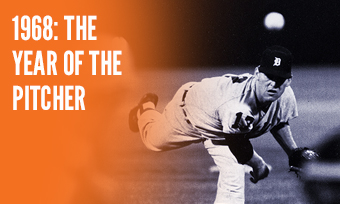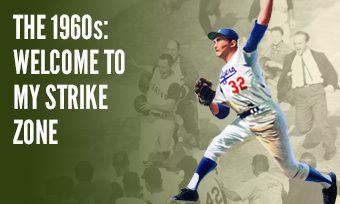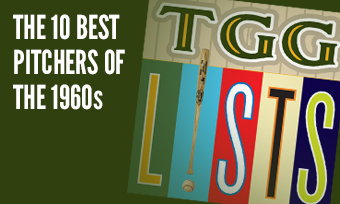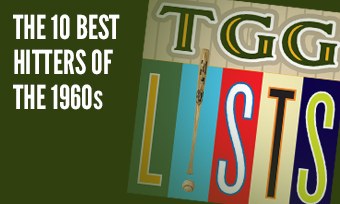The Yearly Reader
Leaders and Honors, 1968
Our list of baseball’s top 10 hitters and pitchers in both the American League and National League for the 1968 baseball season, as well as the awards and honors given to the game’s top achievers of the year.
The National League’s Top 10 Hitters, 1968
Bold type in brick red indicates league leader.
1. Willie McCovey, San Francisco
Key Numbers: .293 average, 81 runs, 36 home runs, 105 RBIs, 72 walks, 20 intentional walks, .545 slugging percentage.
McCovey finally was allowed by the Giants—and successfully proved—to hit full-time against lefties, batting a halfway-decent .253 with nine homers against southpaws.
2. Billy Williams, Chicago
Key Numbers: 163 games, .288 average, 642-at-bats, 91 runs, 185 hits, 30 doubles, 8 triples, 30 home runs, 98 RBIs.
Williams quietly continued to be highly productive and durable, playing every game for the Cubs; for the fifth straight year, he played at least 162 games.
3. Hank Aaron, Atlanta
Key Numbers: .287 average, 84 runs, 174 hits, 33 doubles, 29 home runs, 86 RBIs, 23 intentional walks, 28 stolen bases, 21 grounded into double plays.
Aaron finished a 10-year stretch in which he stole bases at an 80% success rate (203 of 253). His 28 steals in 1968, at the age of 34, were the second highest total of his career.
4. Richie Allen, Philadelphia
Key Numbers: .263 average, 87 runs, 17 doubles, 9 triples, 33 home runs, 90 RBIs, 74 walks.
The Phillies’ star saved his best for last, hitting three home runs on the season’s final day against Tom Seaver (who gave up the first blast) and the Mets.
5. Lou Brock, St. Louis
Key Numbers: .279 average, 92 runs, 184 hits, 46 doubles, 14 triples, 6 home runs, 51 RBIs, 62 stolen bases.
Brock stole three or more bases four times—one more than he did during his record-breaking 118-steal campaign in 1974.
6. Willie Mays, San Francisco
Key Numbers: .289 average, 84 runs, 20 doubles, 5 triples, 23 home runs, 79 RBIs, 12 stolen bases.
Though Mays’ numbers weren’t indicative of better times, they were still an improvement over 1967—and given his age (37) and the year-long dominance of pitchers, that was a good sign.
7. Pete Rose, Cincinnati
Key Numbers: .335 average, 94 runs, 210 hits, 42 doubles, 6 triples, 10 home runs, 49 RBIs, .391 on-base percentage.
Rose defied the pitching madness and became the first switch-hitter to win a NL batting title.
8. Jim Wynn, Houston
Key Numbers: .269 average, 85 runs, 23 doubles, 5 triples, 26 home runs, 67 RBIs, 90 walks, 11 stolen bases, 17 caught stealing.
Wynn was easily the Astros’ biggest power threat; collectively, the team belted only 40 homers without him, with no one player on the roster collecting more than six.
9. Tony Perez, Cincinnati
Key Numbers: .282 average, 93 runs, 176 hits, 25 doubles, 7 triples, 18 home runs, 92 RBIs.
The young Perez showed that he was revving up late for a few thunderous years to follow by batting .326 over his last 73 games.
10. Felipe Alou, Atlanta
Key Numbers: .317 average, 662 at-bats, 72 runs, 210 hits, 37 doubles, 5 triples, 11 home runs, 57 RBIs, 12 stolen bases.
Déjà bro: For the second time in three years, Felipe led the NL in hits but was upstaged by brother Matty, who produced a higher batting average (.332 at Pittsburgh).
The American League’s Top 10 Hitters, 1968
1. Carl Yastrzemski, Boston
Key Numbers: .301 average, 90 runs, 162 hits, 32 doubles, 23 home runs, 74 RBIs, 119 walks, 13 stolen bases, .426 on-base percentage.
Yastrzemski’s production drop was indicative of major league hitters in general, but he was still the AL’s toughest out.
2. Frank Howard, Washington
Key Numbers: .274 average, 79 runs, 164 hits, 28 doubles, 44 home runs, 106 RBIs, .552 slugging percentage.
Howard overcame his habit of hitting bad pitches and put up numbers that didn’t belong in 1968.
3. Ken Harrelson, Boston
Key Numbers: .275 average, 79 runs, 35 home runs, 109 RBIs.
An avid golfer who gave serious consideration to playing in the PGA, Harrelson was among the first to wear batting gloves.
4. Willie Horton, Detroit
Key Numbers: .285 average, 36 home runs, 85 RBIs.
The Tigers slugger hit 26 of his 36 home runs with no one on base; 11 of his bombs came against the Angels alone.
5. Bill Freehan, Detroit
Key Numbers: .263 average, 25 home runs, 84 RBIs, 24 hit-by-pitches.
The 24 plunkings asborbed by Freehan were the most by an American Leaguer since Kid Elberfeld in 1911.
6. Frank Robinson, Baltimore
Key Numbers: 130 games, .268 average, 27 doubles, 15 home runs, 52 RBIs, 73 walks, 12 hit-by-pitches, 11 stolen bases.
A quick glance at Robinson’s numbers and the first words that would come to mind might be, “off-year.” But look more closely, and you might better understand why he placed fifth in OPS (on-base plus slugging percentage).
7. Bert Campaneris, Oakland
Key Numbers: .276 average, 642 at-bats, 87 runs, 177 hits, 25 doubles, 9 triples, 4 home runs, 38 RBIs, 62 stolen bases, 22 caught stealing.
The A’s all-time hit leader led the AL in that category for the only time in his career while stealing at least 50 bases for the fourth straight year, with a personal-best 62.
8. Reggie Jackson, Oakland
Key Numbers: .250 average, 82 runs, 29 home runs, 74 RBIs, 14 stolen bases, 171 strikeouts.
In his first full year, Reggie hit 20 of his 29 home runs away from the A’s new home in Oakland—but also only knocked in 37 runs to go with it.
9. Jim Northrup, Detroit
Key Numbers: .264 average, 76 runs, 29 doubles, 7 triples, 21 home runs, 90 RBIs.
Two of Northrup’s four grand slams came in back-to-back innings on June 24; he had a shot at a third with the bases loaded that same day, but struck out.
10. Roy White, New York
Key Numbers: .267 average, 89 runs, 20 doubles, 7 triples, 17 home runs, 62 RBIs, 73 walks, 20 stolen bases.
Amid the deadwood in the Yankees offense was White, the only player on his team to hit over .245.
The National League’s Top 10 Pitchers, 1968
1. Bob Gibson, St. Louis
Key Numbers: 1.12 ERA, 22 wins, 9 losses, .710 win percentage, 34 starts, 28 complete games, 13 shutouts, 304.2 innings, 62 walks, 268 strikeouts.
Amazingly, for a man who was known for a hard fastball and striking out many an opponent, Gibson led the NL in strikeouts for the first and only time.
2. Gaylord Perry, San Francisco
Key Numbers: 2.44 ERA, 16 wins, 15 losses, 1 save, 39 appearances, 38 starts, 291 innings, 59 walks.
Sign of the times: The Giants scored 22 runs in Perry’s 15 losses.
3. Juan Marichal, San Francisco
Key Numbers: 2.43 ERA, 26 wins, 9 losses, .743 win percentage, 38 starts, 30 complete games, 325.2 innings, 46 walks.
In Bob Gibson’s shadow for the NL’s top spotlight was, once again, Marichal—even as he himself flirted with winning 30 games. Marichal settled for 30 complete games—the most by a Giant since Christy Mathewson in 1914.
4. Steve Blass, Pittsburgh
Key Numbers: 2.12 ERA, 18 wins, 6 losses, .750 win percentage, 31 starts, 7 shutouts, 220.1 innings.
The man whose career would be ruined in the 1970s by a sudden inability to throw strikes averaged a career-low 2.2 walks per nine innings.
5. Don Drysdale, Los Angeles
Key Numbers: 2.15 ERA, 14 wins, 12 losses, 31 starts, 8 shutouts, 239 innings.
Lost amid Drysdale remarkable 58.2-inning scoreless streak was a shoulder injury that ended his season in late August; it was the beginning of a quick downfall that would lead to his retirement a year later.
6. Tom Seaver, New York
Key Numbers: 2.20 ERA, 16 wins, 12 losses, 35 starts, 277.2 innings, 48 walks.
After a fine rookie year, Seaver kept the pace up as he helped the Mets to their best record yet—at 73-89.
7. Ferguson Jenkins, Chicago
Key Numbers: 2.63 ERA, 20 wins, 15 losses, 40 starts, 308 innings, 65 walks, 260 strikeouts.
Jenkins became this era’s Robin Roberts, a guy who gave up an abundance of extra-base hits—he led the NL in home runs and doubles allowed, with 26 and 51, respectively—but still good enough to put together stellar ERA and win totals.
8. Jerry Koosman, New York
Key Numbers: 2.08 ERA, 19 wins, 12 losses, 34 starts, 7 shutouts, 263.2 innings, 23 grounded into double plays.
Thrilled a year earlier with Tom Seaver’s arrival, long-suffering Mets fans doubled their pleasure with the debut of Koosman, who tossed a rookie-record seven shutouts.
9. Ray Washburn, St. Louis
Key Numbers: 2.26 ERA, 14 wins, 8 losses, 30 starts, 215 innings, 47 walks.
Washburn’s no-hitter on September 18—a day after his team was no-hit by the Giants’ Gaylord Perry—was the undisputed highlight of his terrific campaign.
10. Bob Moose, Pittsburgh
Key Numbers: 2.74 ERA, 8 wins, 12 losses, 3 saves, 38 appearances, 22 starts, 170.2 innings, 41 walks.
With a scruffy, slightly pudgy appearance that could have passed him off as a distant relative of John Belushi, Moose ascended from the bullpen in June and put together a fine rookie showing, even if the record didn’t reflect it.
The American League’s Top 10 Pitchers, 1968
1. Luis Tiant, Cleveland
Key Numbers: 1.60 ERA, 21 wins, 9 losses, .700 win percentage, 32 starts, 9 shutouts, 258.1 innings, 264 strikeouts.
Tiant exploded onto the scene with a corkscrew pitching delivery that would be evoked by Hideo Nomo 27 years later.
2. Denny McLain, Detroit
Key Numbers: 1.96 ERA, 31 wins, 6 losses, .838 win percentage, 41 starts, 28 complete games, 336 innings, 63 walks, 280 strikeouts.
Along with Bob Gibson, McLain became part of the first pair of pitchers to both win MVPs in the same season.
3. Dave McNally, Baltimore
Key Numbers: 1.95 ERA, 22 wins, 10 losses, .688 win percentage, 35 starts, 273 innings, 55 walks.
After averaging 10 wins over the previous four seasons, McNally stepped up to a higher plateau with the first of four straight years averaging 20.
4. Wilbur Wood, Chicago
Key Numbers: 1.87 ERA, 13 wins, 12 losses, 16 saves, 88 appearances, 2 starts, 159 innings, 33 walks.
Taught the knuckler by veteran teammate Hoyt Wilhelm, Wood set a then-major league record for appearances—all but two of them from the bullpen—and won more games than any White Sox starter.
5. Sam McDowell, Cleveland
Key Numbers: 1.81 ERA, 15 wins, 14 losses, 37 starts, 269 innings, 110 walks, 283 strikeouts, 10 hit-by-pitches.
Take away his puzzling inability to throw well against last-place Washington—going 1-3 with a 4.37 ERA over five starts—and McDowell would have won the AL ERA title over teammate Luis Tiant with a 1.42 mark.
6. Stan Bahnsen, New York
Key Numbers: 2.05 ERA, 17 wins, 12 losses, 37 appearances, 34 starts, 267.1 innings.
The Yankees hated the idea of the player draft when it began 1965, but it did yield some positive future gains in Bahnsen.
7. Dean Chance, Minnesota
Key Numbers: 2.53 ERA, 16 wins, 16 losses, 43 appearances, 39 starts, 292 innings, 63 walks, 23 stolen bases allowed.
The 27-year-old ace had his last productive year, before back injuries permanently curtailed his career.
8. Mel Stottlemyre, New York
Key Numbers: 2.45 ERA, 21 wins, 12 losses, 36 starts, 278.2 innings, 22 grounded into double plays.
This is how good pitchers had it in 1968: Stottlemyre led the AL in hits allowed (243), and yet opponents batted just .234 against him.
9. Tommy John, Chicago
Key Numbers: 1.98 ERA, 10 wins, 5 losses, 25 starts, 177.1 innings.
John’s stellar season came to an early end when he hurt his shoulder in a late-August fight with Detroit’s Dick McAuliffe.
10. Jim Hardin, Baltimore
Key Numbers: 2.51 ERA, 18 wins, 13 losses, 35 starts, 244 innings.
His rookie year shortened by, of all things, stepping on a stingray, Jim Hardin transferred his pain against opponents in his one solid year.









